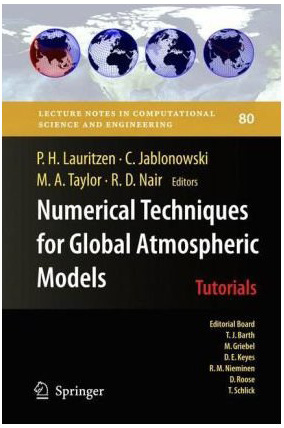|
Home
Publications
Curriculum Vitae
Software
Book
Contact
NCAR
|
People at NCAR: Peter Hjort Lauritzen
Numerical Techniques for Global Atmospheric Models
This book surveys recent developments in numerical techniques for global atmospheric models. It is based upon a collection of lectures prepared by leading experts in the field. The chapters reveal the multitude of steps that determine the global atmospheric model design. They encompass the choice of the equation set, computational grids on the sphere, horizontal and vertical discretizations, time integration methods, filtering and diffusion mechanisms, conservation properties, tracer transport, and considerations for designing models for massively parallel computers. A reader interested in applied numerical methods but also the many facets of atmospheric modeling should find this book of particular relevance.
Table of contents
Part I: Equations of motion and some basic ideas on discretizations
Some basic dynamics relevant to the design of atmospheric model dynamical coresJ.Thuburn, University of Exeter, UK.
Waves, hyperbolicity and characteristics
J.Tribbia, National Center for Atmospheric Research, USA.
Horizontal discretizations: some basic ideas
J.Thuburn, University of Exeter, UK.
Vertical discretizations: some basic ideas
J.Thuburn, University of Exeter, UK.
Time discretization: some basic approaches
D.R.Durran, University of Washington, USA.
Stabilizing fast waves
D.R.Durran, University of Washington, USA.
Part II: Conservation laws, finite-volume methods, remapping techniques and spherical grids
Momentum, vorticity, and transport: considerations in the design of a finite-volume dynamical coreT.Ringler, Los Alamos National Laboratory, USA.
Atmospheric transport schemes: desirable properties and a semi-Lagrangian view on finite-volume discretizations
P.H.Lauritzen, National Center for Atmospheric Research, USA.
P.Ullrich, University of Michigan, USA.
R.D.Nair, National Center for Atmospheric Research, USA.
Emerging methods for atmospheric modeling
R.D.Nair, National Center for Atmospheric Research, USA.
M.Levy, University of Colorado, USA.
P.H.Lauritzen, National Center for Atmospheric Research, USA.
Voronoi tessellations and their application to climate and global modeling
L. Ju, University of South Carolina, USA.
M.Gunzburger, Floria State University, USA..
T.Ringler, Los Alamos National Laboratory, USA.
Part III: Practical considerations for dynamical cores in weather and climate models
Conservation in dynamical cores: what, how, and why?J.Thuburn, University of Exeter, UK.
Conservation of mass and energy for the moist atmospheric primitive equations on unstructured grids
M.A. Taylor, Sandia National Laboratories, USA.
The pros and cons of diffusion, filters and fixers in atmospheric general circulation models
C.Jablonowski, University of Michigan, USA.
D.L.Williamson, National Center for Atmospheric Research, USA.
Kinetic energy spectra and model filters
W.Skamarock, National Center for Atmospheric Research, USA.
A perspective on the role of the dynamical core in the development of weather and climate models
R.B.Rood, University of Michigan, USA.
Refactoring scientific applications for massive parallelism
J.Dennis & R.Loft, National Center for Atmospheric Research, USA.
Links:
NCAR
Personal home page of Peter Hjort Lauritzen
Last updated: April-2011
aaaa aaaa aaaa aaaa aaaa aaaa aaaa aaaa aaaa aaaa aaaa aaaa aaaa aaaa aaaa aaaa aaaa aaaa aaaa aaaa aaaa aaaa aaaa aaaa aaaa aaaa aaaa aaaa aaaa aaaa aaaa aaaa aaaa aaaa aaaa aaaa aaaa

